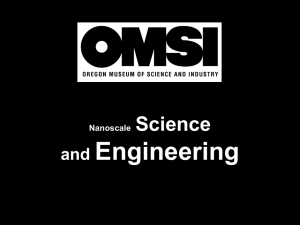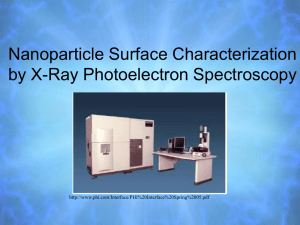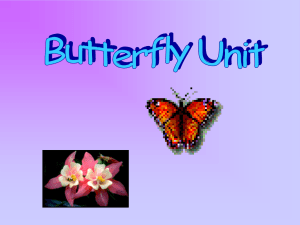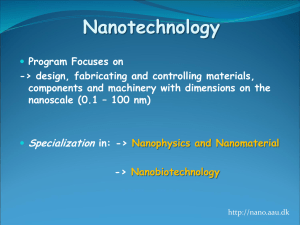Some of these demos were purchased and have links to very
advertisement
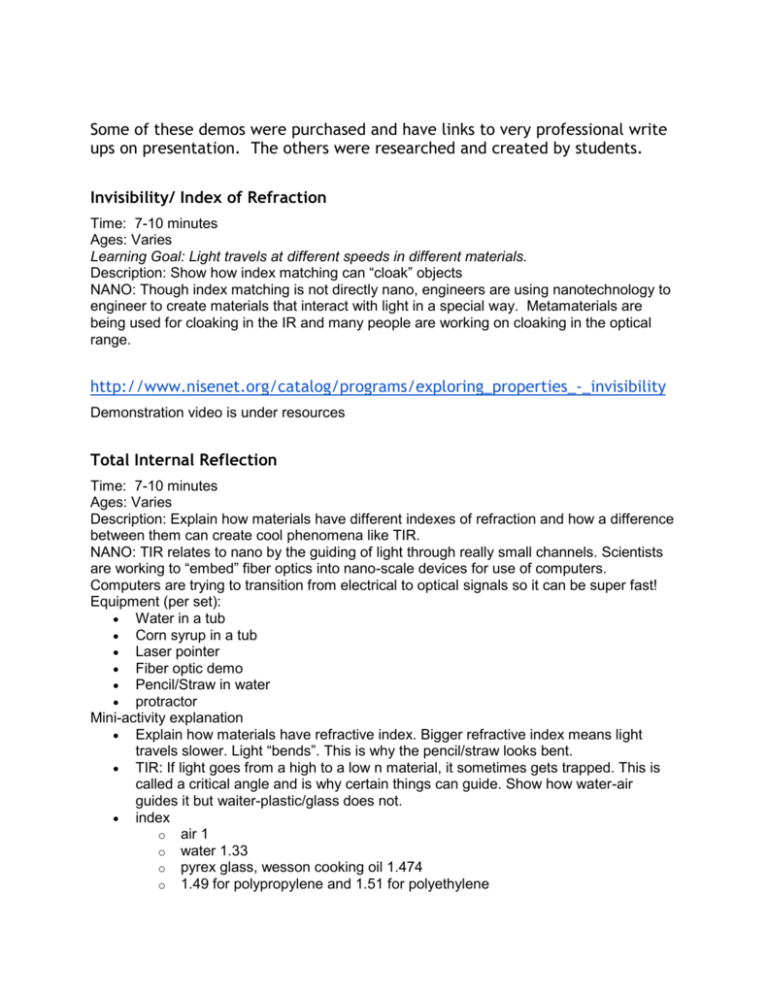
Some of these demos were purchased and have links to very professional write ups on presentation. The others were researched and created by students. Invisibility/ Index of Refraction Time: 7-10 minutes Ages: Varies Learning Goal: Light travels at different speeds in different materials. Description: Show how index matching can “cloak” objects NANO: Though index matching is not directly nano, engineers are using nanotechnology to engineer to create materials that interact with light in a special way. Metamaterials are being used for cloaking in the IR and many people are working on cloaking in the optical range. http://www.nisenet.org/catalog/programs/exploring_properties_-_invisibility Demonstration video is under resources Total Internal Reflection Time: 7-10 minutes Ages: Varies Description: Explain how materials have different indexes of refraction and how a difference between them can create cool phenomena like TIR. NANO: TIR relates to nano by the guiding of light through really small channels. Scientists are working to “embed” fiber optics into nano-scale devices for use of computers. Computers are trying to transition from electrical to optical signals so it can be super fast! Equipment (per set): Water in a tub Corn syrup in a tub Laser pointer Fiber optic demo Pencil/Straw in water protractor Mini-activity explanation Explain how materials have refractive index. Bigger refractive index means light travels slower. Light “bends”. This is why the pencil/straw looks bent. TIR: If light goes from a high to a low n material, it sometimes gets trapped. This is called a critical angle and is why certain things can guide. Show how water-air guides it but waiter-plastic/glass does not. index o air 1 o water 1.33 o pyrex glass, wesson cooking oil 1.474 o 1.49 for polypropylene and 1.51 for polyethylene Water-air - 50 degrees Corn Syrup - Air - 42 degrees Diffraction Time: 7-10 minutes Ages: Varies Learning Goal: Light behaves as a wave and interference causes patterns. Description: Demonstrate diffraction principles to students. Show NANO: Nano related because diffraction occurs when light hits a very small object. Equipment (per set): Single pinhole for circular diffraction pattern -- older students CD with a bunch of holes for squared diffraction pattern -- older students Rainbow peepholes Laser pointer CD, DVD- 400 nm pits, Blu-Ray 150nm pits Mini-activity explanation CDs act as a diffraction grating ie split light into many pieces o Shine whitelight for rainbow via reflection o Shine laser pointer for use as a reflection grating (here) o Shine laser pointer for diffraction grating via transmission (here) Rainbow peepholes show how white light splits into many colors (ROYGBIV) Polarization Time: 7- 10 minutes Ages: Varies Description: Show how light has polarized parts NANO: Nano related because polarization is used to determine things Equipment (per set): 2 Linear Polarizers Cornsyrup tub for cornsyrup White flashlight Laptop Screen or LCD Also add birefringence Mini-activity explanation Show how your computer screen dims until it entirely disappears as you rotate the polarizer. Explain how you are blocking out the light. Polarized sunglasses do the same thing. Put cornsyrup in a tub and shine a flashlight through one side with a polarizer. Have kids look through other side with polarizers and rotate it to see the colors change. Cornsyrup rotates the polarization of the light wave. Photoelasticity could be added if time Reflection Filters Try this! 1. Examine the blue and yellow butterflies. Try tilting the case to see the butterflies from different angles. And be sure to look at both the front and back! 2. Shine the light through the butterflies, holding the light underneath the case. Do the butterflies look the same with the light passing through them? Tip: Squeeze the mini-light to turn it on. What’s going on? When you turn on the light, the yellow butterfly stays yellow, but the blue butterfly turns brown! That’s because the yellow color comes from pigment, but the blue is created by the interference of light bouncing off tiny nanostructures. The Blue Morpho’s wings have very small overlapping scales covered with tiny “ribs.” The size and arrangement of these nanostructures makes the wings look blue—but they’re actually transparent! There’s an air space of a few nanometers between the ribs. Light waves bouncing off the top and bottom surfaces of neighboring ribs interfere with each other. Most light waves are cancelled by the interference and only certain wavelengths— seen as colors—bounce back to your eyes. So when you look at the front of the butterfly, it’s a beautiful, iridescent blue. Light reflecting off the wings When the bright light passes through the Blue Morpho’s wings, the effect is lost and you see the wings’ brown undersides. The back side of the wings is colored by pigment—so the brown side always looks brown. Light passing through the wings How is this nano? The way a material behaves on the macroscale is affected by its structure on the nanoscale. Nanotechnology takes advantage of different material properties at the nanoscale to make new materials and tiny devices smaller than 100 nanometers in size. (A nanometer is a billionth of a meter.) Nanotechnology allows scientists and engineers to make things like smaller, faster computer chips and new medicines to treat diseases like cancer. Low-energy display Some nanotechnology and nanomaterials are inspired by nature. Scientists are working on new nanotechnologies that mimic the Blue Morpho’s wings. They’ve already invented low-energy smartphone displays, paints, and fabrics that change color by changing the spacing between materials. Learning objectives 1. The way a material behaves on the macroscale is affected by its properties on the nanoscale. 2. Some nanotechnologies are inspired by nature. Materials Butterflies in protective case Mini-light “Blue Morpho Butterfly” image sheet Blue Morpho and Buttercup butterflies mounted in an acrylic case are available at www.butterflyutopia.com. Mini-lights (extra-bright LEDs) are available from www.teachersource.com. Notes to the presenter If you’re doing this activity near a bright window or other light source, the mini-light may not be effective. You might be able to hold the butterfly up to the window or light source to get the same effect (and not use the mini-light at all), or you might need to relocate the activity to a less brightly lit area. Extension Visitors can experiment further by dropping alcohol onto a Blue Morpho butterfly wing. The alcohol fills up the spaces between the nanoscale structures of the wings, so they reflect green light waves rather than blue light waves. When the alcohol evaporates, the wings look blue again. Related educational resources The NISE Network online catalog (www.nisenet.org/catalog) contains additional resources to introduce visitors to light and color at the nanoscale, and connections between nanotechnology and nature: Public programs include Biomimicry: Synthetic Gecko Tape through Nanomolding; Colors at the Nanoscale: Butterflies, Beetles and Opals; DNA Nanotechnology; Lotus Leaf Effect; and Nanoparticle Stained Glass, Sand, Plants and Pants. NanoDays activities include Exploring Materials—Liquid Crystals, Exploring Materials—Nano Gold, Exploring Materials—Thin Films, Exploring Products—Nano Fabric, Exploring Products— Sunblock, and Exploring Structures—DNA. Media include Multimedia Zoom into a Nasturtium Leaf, Zoom into the Blue Morpho Butterfly, and Zoom into a Butterfly Wing. Exhibits include Bump and Roll, Changing Colors, and Unexpected Properties. Credits and rights Image of structures in Blue Morpho wing courtesy S. Yoshioka, Osaka University. Images of Blue Morpho wing with reflected and nonreflected light courtesy F. Nijhout, Duke University. Low-energy display photo courtesy Qualcomm Technologies, Inc. This project was supported by the National Science Foundation under Award No. 0940143. Any opinions, findings, and conclusions or recommendations expressed in this program are those of the author and do not necessarily reflect the views of the Foundation. Copyright 2011, Sciencenter, Ithaca, NY. Published under a Creative Commons AttributionNoncommercial-ShareAlike license: http://creativecommons.org/licenses/by-nc-sa/3.0/us/. UV Beads Time: 7-10 minutes Ages: Varies Learning Goal: the absorption of UV light can alter the properties of a material Description: Show how UV beads can change color when exposed to UV light, you can also show how sunscreen can “protect” the bead and stop the color change. http://www.nisenet.org/sites/default/files/catalog/uploads/11095/propertiesuv_guide_01nov2 012.pdf
